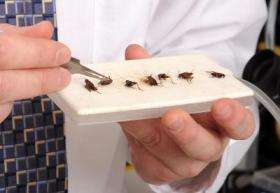Crickets may predict human survivability during global warming

How well crickets adapt to rising temperatures may provide clues about whether or not humans can survive global warming.
UCF scientist Wade Winterhalter landed an $860,000 grant from the U.S. Department of Energy for an innovative study that fuses global warming models with a biological model that predicts the reproduction patterns of the striped ground cricket, also known as the Allonemobius socius.
If successful, Winterhalter's study could provide insights into the impact of global warming on other creatures, their life cycles and their migration patterns - and it could further the understanding of how global warming will affect mankind.
"We, as scientists, are no longer trying to determine if global warming is occurring or if it will be 'bad' for our native wildlife or our domesticated plants and animals," said Winterhalter. "Those questions have already been answered. What this project does is determine exactly how 'bad' it is going to get and how much time we have before these negative consequences will occur."
This is one of the first research projects that links Atmospheric Oceanic General Circulation Models that predict rises in temperature over time with a sound biological model that successfully predicts breeding patterns of a creature.
Winterhalter is working with UCF biology professor Kenneth Fedorka and genetic experts at Cornell University. The study concludes in 2011, but Winterhalter is already analyzing some preliminary data.
Winterhalter chose crickets because their life and reproduction cycles are triggered by temperature cues. When it gets colder, they lay diapause eggs that can survive through winter before hatching. When it is still warm, they lay eggs that develop quickly into crickets. Crickets in the northern U.S. are better at laying the dormant eggs, while those in the south are better are reproducing quickly while it is still hot.
Winterhalter and his team took cricket samples in summer 2006, and he is now working on breeding a second generation of crickets that is enduring current temperature conditions and those expected in 2025 and 2050. The next generation of the crickets will face temperatures expected in 2065 and 2080, and the final group will see temperatures expected in 2100. Altogether, the temperature will increase by 6 degrees Celsius (10.8 degrees Fahrenheit) from the start to finish of the study.
Winterhalter is simulating the daily and seasonal changes crickets are expected to experience during a growing season. Temperatures in the incubators start off low in the morning, increase until a little after noon and then decrease in the evening and into the night, when the lights shut off. In the morning, the lights come back on and the cycle begins again.
The entire experiment will include about 75,000 crickets, which eat carrots and kitten chow.
Existing studies show that when creatures are faced with changes in their environment, the impact can range from slow adaptation to extinction.
Winterhalter expects that once the study is finished, his innovative approach will be adapted to fit other creatures, such as lizards and frogs.
"One of the most exciting aspects of this project from a scientific perspective is that we are attempting to build a bridge between two fields that historically have had very little interaction," Winterhalter said. "By bringing together both climatologists and evolutionary ecologists, this project has the potential of making major advances in both fields."
Source: University of Central Florida


















